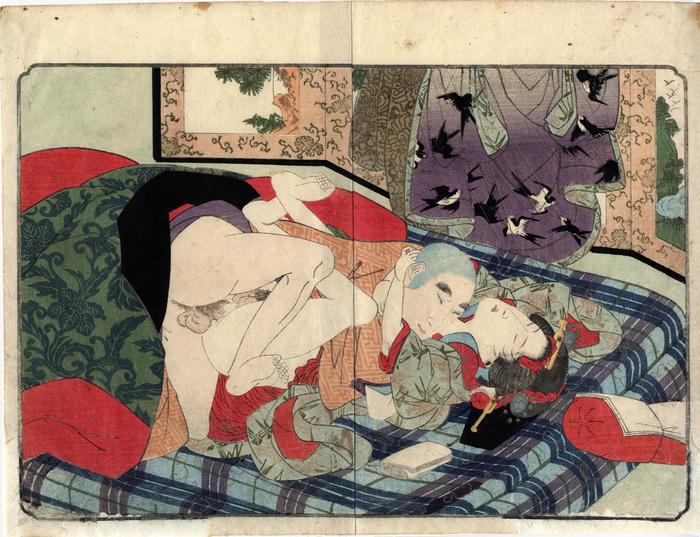Yanagawa Shigenobu I (柳川重信) (artist 1787 – 1832)
Priest having sex with a boy prostitute (kagema - 蔭間) - from Ama no Ukibashi - 'The Floating Bridge of Heaven'
ca 1830
13.125 in x 10 in (Overall dimensions) color woodblock print
Metropolitan Museum of Art - the whole series with text
Lyon Collection - a copy of the ehon but without the intermediary texts This scene from Shigenobu's excellent shunga Ama no Ukibashi - 'The Floating Bridge of Heaven' (3 vols w/ 21 works and text) presents a chief priest making love to a male najimi (regular partner). Their passionate encounter is emphasized by the red kukuri makura (stuffed roll pillow) which has fallen off the bedding.
The reference to Ukibashi (or Ukihashi, in many texts) is the most ancient reference to sex in Japanese literature. It first appeared in the Kojiki when Izanagi and Izanami, brother and sister gods, were standing on the bridge watching the movements of a wagtail, a bird, and got the idea of how to have sex. From that resulted the islands of Japan, many other gods, and eventually the Imperial family as direct descendants. Therefore, the title of this ehon in which this image appears is rich in meaning and historical references.
****
A kagema was a homosexual prostitute that sold his services at banquets.
"In Edo-period popular discourse, the work [wakashu] has at least three relatively distinct meanings. At its broadest, wakashu simply refers to an adolescent male... The second use of the word is as one of a pair of terms: nenja and wakashu. These refer to an adult male lover adn the younger male object fo his affection, respectively.... In the third usage, later in the seventeenth century, the term was also used as a synonym for boy prostitutes associated with the kabuki stage, or kagema, apprentice actors who stayed "in the shadows" (kage no ma) and functioned chiefly as sex workers."
Quoted from: 'Wakashu as a third gender and gender ambiguity through the Edo Period' by Joshua S. Mostow, in A Third Gender: Beautiful Youths in Japanese Edo-Period Prints and Paintings, p. 19.
****
Illustrated in color online in a Master's Degree in East Asian Studies, 'La homosexualidad en Japón y sus representaciones artísticas', by Daniel Rodríguez Fernández, from the University of Salamanca, 2016, p. 57.
The author wrote: "Aparece un sacerdote, fácilmente reconocible por presentar la cabeza rapada, haciendo el amor con lo que parece ser un kagema. Parece ser un kagemajaya debido a que no parecen ser las estancias de un monasterio, sino de una habitación de una casa de té.
Alcontrario que el resto de las estampas, el plano que aparece aquí es un picado, lo que provoca que sea aún más difícil encontrar la profundidad en la imagen."
A loose translation via Google reads: "A priest appears, easily recognizable for his shaved head, making love to what appears to be a kagema. He appears to be a kagemajaya because they do not appear to be the rooms of a monastery, but rather a room in a tea house.
Unlike the rest of the prints, the plane that appears here is a jagged one, which makes it even more difficult to find depth in the image."
erotic prints (shunga - 春画) (genre)
picture book (ehon - 絵本) (genre)
Kyōto-Osaka prints (kamigata-e - 上方絵) (genre)
